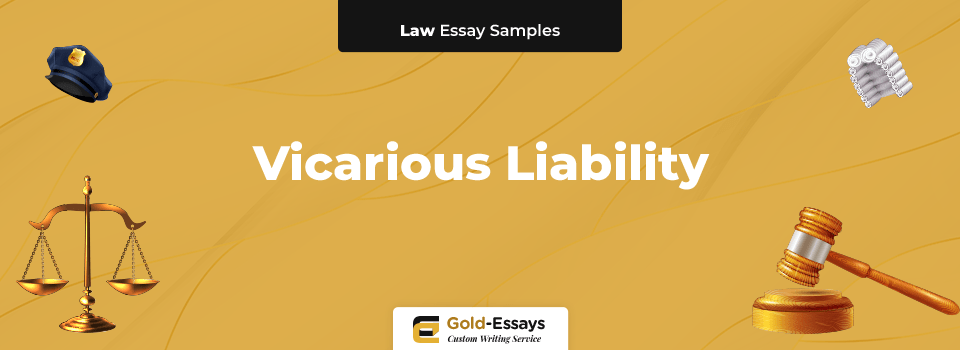
In the labyrinth of legal principles that keep our society’s wheels turning smoothly, vicarious liability stands out for its intriguing premise: holding someone legally responsible for another’s actions. This concept, which finds its roots deeply embedded in business law, casts a wide net, ensnaring those who, though not directly at fault, have a legal relationship with the actual wrongdoer. The evolution and nuances of this principle reveal the complexity of assigning blame within the legal domain, illuminating its pivotal role in maintaining accountability across the board.
Usually, vicarious liability is imposed on the second person for crimes that the first person might have committed even if the second person had no connection with the crimes that occurred. While the origins of vicarious liability are not well documented, it has been used in the common law for a few centuries. The comprehensive explanation of vicarious liability can demonstrate why it is mainly applied to the employee-employer relationship. The justification for the doctrine of vicarious liability is rationally elucidated in the relationship between an employee and employer. The employer is obligated and, thus, liable for the employee from the moment the employment contract was signed by both parties. Therefore, the responsibility for the employee’s actions is of prime importance and can at times be costly for the company. Therefore, if someone tries to examine the employee-employer relationship, it will become evident that the promised contract must be fair and make sense for both parties accordingly. If an act of negligence occurs unintentionally, then the employer will take responsibility since even the most cautious people can sometimes commit mistakes. There are also cases when the intentional type of misconduct is covered with vicarious liability if actions that occurred can be categorized as an honest presentation of the contract. In any other cases, legal liability for intentional negligence will be omitted because it does not seem rational for an employer to compensate for events which could have been controlled (Q.L.R.C., 1995).
A variety of reasons have been forwarded to explain and justify the principle of vicarious liability. One ethical concept for explaining the doctrine of vicarious liability is the idea that an employer can better increase the legal costs related to the case by having the necessary insurance or increasing the prices. Secondly, the infliction of liability should lead the employer to the provision of better safety conditions for people working in their company. Thus, it was always believed that the principle of vicarious liability has its roots rather in social norms and justice than in any concise and easily explainable legal principles. Thirdly, the employer should cover any losses caused by employees because they make profit from their activities; otherwise, there would not be a need to have employees.
When exploring the doctrine of vicarious liability from a legal point of view, it is important to note three simple prerequisites to ascribe liability to an employer. The first requirement is to understand whether the tort was carried out by an employee. Afterwards, it is crucial to demonstrate the relationship between the boss and the employee. Lastly, it is crucial that the tort happened during the legal employment of a person who committed it. If one wants to identify vicarious liability, then it is essential to be able to identify the employee because the legal definition of an employee may be quite dubious at times. Thus, liability will begin to differ when one establishes what kind of employee is hired. When an independent contractor is hired, it is important to identify the exact terms of the contract and insure that both parties understand how they are categorized under the contract. The difference is that the contractor will usually provide service and assume liability for the job, while employee’s activities will be the responsibility of the employer (Neyers, 2005).
Another legal aspect of the doctrine is the ground rules that establish what constitutes a course of employment. Since this question depends on individual cases, it is quite difficult to establish under the common law what represents a course of employment. The course of employment includes the actual time during which the employee is on the premises of the employer, including the cases of recreational events organized for business reasons. Therefore, any action authorized by the employer for the purpose of executing an event for the business, whether legal or illegal, is considered under the course of employment and becomes liability of the employer (Schwartz, 1996).
In the modern law, it is considered that the concept of vicarious liability is not applied to the criminal law. The argument consists of the general principle that a person who planned and executed a crime should take responsibility. The concept of having one person liable for the wrongdoings of someone else is not applied in criminal law today. In the modern world, the concept of vicarious liability is mostly applied in cases that affect the welfare of people and do not involve imprisonment. The main goal of utilizing the doctrine is to protect public interests as well as impose the creation of harsher rules and closer supervision by employers (Simons, 2008).
The concept of vicarious liability represents a remedy for victims of abuse in the workplace to have fair treatment from employers under the principle of justice and good conscience. Thus, the distinction between intentional and unintentional wrongdoing in the course of employment will increase the effectiveness of applying the concept of vicarious liability to the advantage of the employee and employer accordingly.


